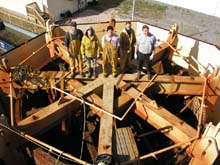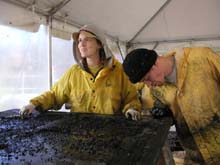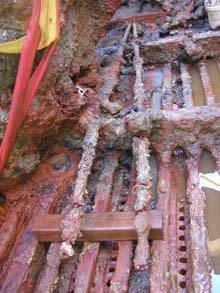
(From l to r) Mike Hughes, Kate Goodall, Jason Paling, Alena Derby and Tane Casserley stand on top of the "spider" after a tough day working inside and outside the turret. Click image for larger view and detailed explanation.

Kate Goodall and Jason Paling, both ECU students, carefully look for artifacts as they sift through soft sediment. Click image for larger view and detailed explanation.

Two rods, seen here concreted to the turret roof's support beams, were removed earlier this week. Click image for larger view and detailed explanation.
A "Hands-on" History Lesson
November 15, 2002
Michelle Fox
Education and Outreach Coordinator
Monitor National Marine Sanctuary
For the period of November 6 - 15, 2002
Several student volunteers from East Carolina University (ECU) joined Sanctuary and Museum staff this week to help with the excavation of the Monitor’s turret. Kate Goodall, Mike Hughes, Jason Paling and Alena Derby, graduate students of ECU’s Maritime Studies Program, spent the week sifting through sediment removed from the turret.
“It was a once-in-a-lifetime experience working next to the Monitor’s world-famous gun turret,” said Kate Goodall. “I’ve only seen it in history books and photographs. I never thought I’d get an opportunity like this to see the turret up close and personal.”
Thanks to the diligent work of the ECU students, NOAA archaeologist Tane Casserley was able to remove two rods from the turret. These rods, previously concreted to the roof of the turret, are associated with the gun implements that sailors used to pack powder and shot into the Dahlgren cannons.
“It was wonderful having the ECU students here this week,” said Casserley. “Working outside under the current weather conditions can be miserably wet and cold, but the students had a positive attitude throughout it all.”
After months of excavation, the port side of the turret is finally clear of all soft and hard material and most of the large components have been removed. The diagonal braces, the gun carriage and the gun still remain in this section. Excavators will continue to remove similar material on the starboard side.
Next week, several students from the College of William and Mary in Williamsburg, Va., will be here to help. We look forward to seeing them!
Sign up for the Ocean Explorer E-mail Update List.

































